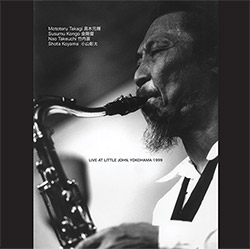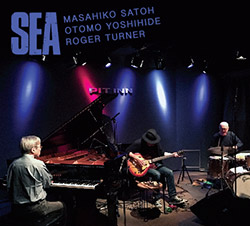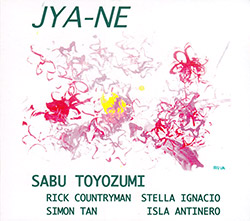![Satoh, Masahiko / Sabu Toyozumi: The Aiki [VINYL] (NoBusiness) Satoh, Masahiko / Sabu Toyozumi: The Aiki [VINYL] (NoBusiness)](https://www.teuthida.com/productImages/misc4/28276.jpg)
Working together often over decades, free improvising drummer Sabu Toyozumi and composer/improvising pianist Masahiko Satoh are heard here in a 1997 duo concert at C S Aka-Renga, in Yamaguchi City, Japan, for an engaging concert of energetic interaction, emphasizing Satoh's percussive approach to the keys and Sabu's inherent melodicism in his approach to drumming.
Out of Stock
Quantity in Basket: None
Log In to use our Wish List
Shipping Weight: 22.00 units
Sample The Album:
Masahiko Satoh-piano
Sabu Toyozumi-drums
Click an artist name above to see in-stock items for that artist.
Label: NoBusiness
Catalog ID: NBLP 129
Squidco Product Code: 28276
Format: LP
Condition: New
Released: 2019
Country: Lithuania
Packaging: LP
Recorded live at C S Aka-Renga, in Yamaguchi City, Japan, on March 26th, 1997, by Takeo Suetomi.
Working together often over decades, free improvising drummer Sabu Toyozumi and composer/improvising pianist Masahiko Satoh are heard here in a 1997 duo concert at C S Aka-Renga, in Yamaguchi City, Japan, for an engaging concert of energetic interaction, emphasizing Satoh's percussive approach to the keys and Sabu's inherent melodicism in his approach to drumming.
Also available on CD.Artist Biographies
• Show Bio for Masahiko Satoh "Masahiko Satoh (佐藤允彦 Satoh Masahiko, born 6 October 1941) is a Japanese jazz pianist, composer and arranger. Satoh was born in Tokyo on 6 October 1941. His mother was Setsu and his father, who owned small businesses, was Yoshiaki Satoh. The house that his family moved into in 1944 contained a piano; Masahiko started playing it at the age of five. He began playing the piano professionally at the age of 17, "accompanying singers, magicians and strippers at a cabaret in the Ginza district". By 1959 Satoh was playing in Georgie Kawaguchi's band, together with alto saxophonist Sadao Watanabe and tenor saxophonist Akira Miyazawa. Satoh graduated from Keio University. At the age of 26, Satoh moved to the United States to study at the Berklee College of Music. He stayed for two years, during which he read about composing and arranging. He earned money working in a food shop and playing the piano in a hotel. In 1968 he wrote the music for, and conducted, a series of pieces that were combined with dance and performed in New York. After returning to Japan, he recorded Palladium, his first album as leader, and appeared on a Helen Merrill album. In his early career in the late 1960s and early 1970s, Satoh played in a free, percussive style. Satoh played at the 1971 Berlin Jazz Festival as part of a trio; he used a then-unusual ring modulator to alter the sound. Also in the early 1970s, he recorded with Attila Zoller, Karl Berger, and Albert Mangelsdorff. He wrote the psychedelic music for the 1973 anime film Belladonna of Sadness. Satoh has written arrangements for recordings led by, among others, Merrill, Kimiko Itoh, and Nancy Wilson. He also arranged for strings and quartet on Art Farmer's 1983 album Maiden Voyage. In 1990 Satoh formed a large group, named Rantooga, that combined various forms of folk musics from around the world. In the early 1990s he composed music for a choir of 1,000 Buddhist monks. In the early 1990s he was reported as stating that 70% of his time was spent on arranging and composing, and the rest on playing and recording. Satoh has composed for film, television and advertisements. For instance, he made the music of Kanashimi no Belladonna, a film in which the sound is very important ; all the songs of this movie are performed by his wife, Chinatsu Nakayama. Some of his compositions are influenced by the space in the works of composer Toru Takemitsu. Satoh has also composed for traditional Japanese instruments, including the shakuhachi and biwa." ^ Hide Bio for Masahiko Satoh • Show Bio for Sabu Toyozumi "Yoshisaburo "Sabu" Toyozumi (born Tsurumi, Yokohama, 1943) is one of the small group of musical pioneers who comprised the first generation playing free improvisation music in Japan. As an improvising drummer he played and recorded with many of the key figures in Japanese free music including the two principal figures in the first generation, Masayuki Takayanagi and Kaoru Abe from the late 1960s onwards. He is one of a very few of this circle who are still alive and engaged in playing this music today. Toyozumi features on numerous commercially available recordings with many of the most notable Japanese and international improvising musicians including Derek Bailey, Mototeru Takagi, Misha Mengelberg, Peter Brötzmann, Keiji Haino, Otomo Yoshihide, Tom Cora and Fred Van Hove. In 1971 he became the only non-American member of the Association for the Advancement of Creative Musicians(AACM)). He dedicated his first record as a leader, Sabu - Message to Chicago, to compositions by AACM members, and in 1992 toured and recorded with AACM trumpeter Wadada Leo Smith. Toyozumi has been instrumental in bringing many European and American improvisers to Japan including Derek Bailey, Misha Mengelberg and Sunny Murray. In 2005 British improvising guitarist and promoter John Russell arranged a two-day event dedicated to Toyozumi in which the drummer performed in different groupings with 14 musicians from the London improvised music scene including, most notably, Evan Parker, Lol Coxhill, Phil Minton, John Edwards and Steve Beresford. The Wire described his playing at this time as follows: "He's busy, but there's always space between his notes, and he avoids the flashy technical solution to musical problems. His playing is crisp and dramatic, with a very occasional use of repetition to spark a climax. If it's possible for a drum kit to ask awkward questions, Toyozumi seems to be doing it". In an interview with Cadence Magazine in 1988 Toyozumi makes clear the importance of his relationship with nature as an influence on his playing and Clive Bell writing in The Wire in 2005 notes "his devotion to the way of Watazumido, the late shakuhachi player and Zen master, whose performances mixed martial arts and music in a bizarre cocktail of discipline and craziness". In 2009 he returned to London to feature as one of the players in Russell's improvisation festival Fete Quaqua which was recorded for broadcast by BBC Radio 3. He continues to tour widely and in the past year or so has performed in Belgium and France, Chile, Taiwan, England, Philippines and Greece. He also performs from time to time with the legendary Japanese noise group Hijokaidan. Currently he can be found performing on the erhu - a two-stringed Chinese violin - as often as playing the drums." ^ Hide Bio for Sabu Toyozumi
11/20/2024
Have a better biography or biography source? Please Contact Us so that we can update this biography.
11/20/2024
Have a better biography or biography source? Please Contact Us so that we can update this biography.
Track Listing:
SIDE A
1. The Move for The Quiet 37:25
SIDE B
1. The Quiet for the Move 19:52
Vinyl Recordings
Improvised Music
Jazz
Free Improvisation
Asian Improvisation & Jazz
Duo Recordings
Piano & Keyboards
Percussion & Drums
Search for other titles on the label:
NoBusiness.


![Satoh, Masahiko / Sabu Toyozumi: The Aiki [VINYL] (NoBusiness) Satoh, Masahiko / Sabu Toyozumi: The Aiki [VINYL] (NoBusiness)](https://www.teuthida.com/productImages/full/28276.Full.jpg)













![Guy, Barry / Ken Vandermark: Occasional Poems [2 CDs]](https://www.teuthida.com/productImages/misc4/34849.jpg)
![Novoa / Carter / Mela Trio: Vol.1 [VINYL]](https://www.teuthida.com/productImages/misc4/35236.jpg)


![Elephant9 : Mythical River [VINYL]](https://www.teuthida.com/productImages/misc4/34624.jpg)
![Evans, Peter (Evans / Eldh / Black): Extra [VINYL]](https://www.teuthida.com/productImages/misc4/35279.jpg)

![McPhee, Joe: Straight Up, Without Wings [BOOK]](https://www.teuthida.com/productImages/misc4/35454.jpg)
![Jeck, Philip: rpm [2 CDs]](https://www.teuthida.com/productImages/misc4/35455.jpg)













![Barker / Parker / Irabagon: Bakunawa [VINYL]](https://www.teuthida.com/productImages/misc4/35533.jpg)
![Blaser, Samuel / Marc Ducret / Peter Bruun: Dark Was The Night, Cold Was The Ground [VINYL 10-inch]](https://www.teuthida.com/productImages/misc4/35492.jpg)








![Warren, Kenny (Warren / Hoffman / Ellman): Sweet World [VINYL]](https://www.teuthida.com/productImages/misc4/35451.jpg)




![Blake, Ran / Dave Knife Fabris: Live Amsterdam 2006, First Visit [CD + POSTCARDS]](https://www.teuthida.com/productImages/misc4/35275.jpg)













![DNS: Taking Big Bites Of The Khandas Three Cafes Deep [2 CDs]](https://www.teuthida.com/productImages/misc4/35334.jpg)




![Cleaver, Gerald: The Process [VINYL]](https://www.teuthida.com/productImages/misc4/34966.jpg)




![Alva Noto: HYbr:ID II [VINYL 2 LPs]](https://www.teuthida.com/productImages/misc4/35201.jpg)

![Baron, Derek / Luke Martin: Distinct and Concealed [CASSETTE + DOWNLOAD]](https://www.teuthida.com/productImages/misc4/35079.jpg)

![Lyle, Erica Dawn : Colonial Motels [CASSETTE + DOWNLOAD]](https://www.teuthida.com/productImages/misc4/35080.jpg)









![Sanna, Claudio: Compositori Sardi Contemporanei II [2 CDs]](https://www.teuthida.com/productImages/misc4/35317.jpg)







![Zurria, Manuel: Fame di Vento [3 CDs]](https://www.teuthida.com/productImages/misc4/35167.jpg)

![Granberg, Magnus / Nattens Inbrott / Skogen: Holde Traume, Kehret Wieder! [2 CDs]](https://www.teuthida.com/productImages/misc4/35038.jpg)
![Frey, Jurg: Outermost Melodie [2 CDs]](https://www.teuthida.com/productImages/misc4/35039.jpg)

![Pavone, Jessica: Reverse Bloom [VINYL]](https://www.teuthida.com/productImages/misc4/34895.jpg)




![Modney (Modney / Wooley / Gentile / Roberts / Pluta / Symthe / ...): Ascending Primes [2 CDs]](https://www.teuthida.com/productImages/misc4/34852.jpg)









![Elephant9 with Terje Rypdal: Catching Fire [VINYL 2 LPs]](https://www.teuthida.com/productImages/misc4/35355.jpg)
![Deerlady (Obomsawin, Mali / Magdalena Abrego): Greatest Hits [VINYL]](https://www.teuthida.com/productImages/misc4/34876.jpg)




![Haino, Keiji: Black Blues [2 CDs]](https://www.teuthida.com/productImages/misc4/35109.jpg)



![Surplus 1980: Illusion of Consistency [CD]](https://www.teuthida.com/productImages/misc4/35069.jpg)
![Staiano, Moe: Away Towards the Light [VINYL + DOWNLOAD]](https://www.teuthida.com/productImages/misc4/35037.jpg)



![Caveira (Gomes / Sousa / Abras / Ferrandini): Ficar Vivo [VINYL]](https://www.teuthida.com/productImages/misc4/34643.jpg)
![Gregg, J. J. / David Van Auken: Lunar Prairie [CD w/ DOWNLOAD]](https://www.teuthida.com/productImages/misc4/34611.jpg)

![Coultrain: Mundus [VINYL]](https://www.teuthida.com/productImages/misc4/32439.jpg)
![Mattin: Songbook #6 [VINYL]](https://www.teuthida.com/productImages/misc4/27317.jpg)
![Punkappella: Wake Up [7-inch VINYL]](https://www.teuthida.com/productImages/misc4/17519.jpg)
![Residents, The: WARNING: UNiNC.: Live And Experimental Recordings 1971-1972 [VINYL 2 LPs]](https://www.teuthida.com/productImages/misc4/31521.jpg)
![Coultrain: Phantasmagoria [VINYL]](https://www.teuthida.com/productImages/misc4/30142.jpg)
![Lennon, Sean Ono: Asterisms [VINYL]](https://www.teuthida.com/productImages/misc4/34517.jpg)

![Coley, Byron: Dating Tips for Touring Bands [VINYL]](https://www.teuthida.com/productImages/misc4/17906.jpg)

![Lost Kisses: My Life is Sad & Funny [DVD]](https://www.teuthida.com/productImages/misc4/lostKissesDVD.jpg)